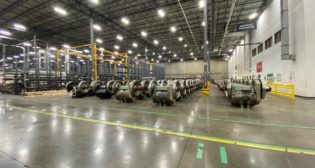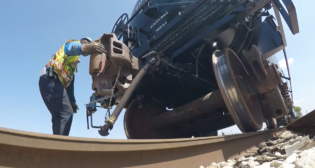
Smoothing the Wheel/Rail Interface
Written by Marybeth Luczak, Executive Editor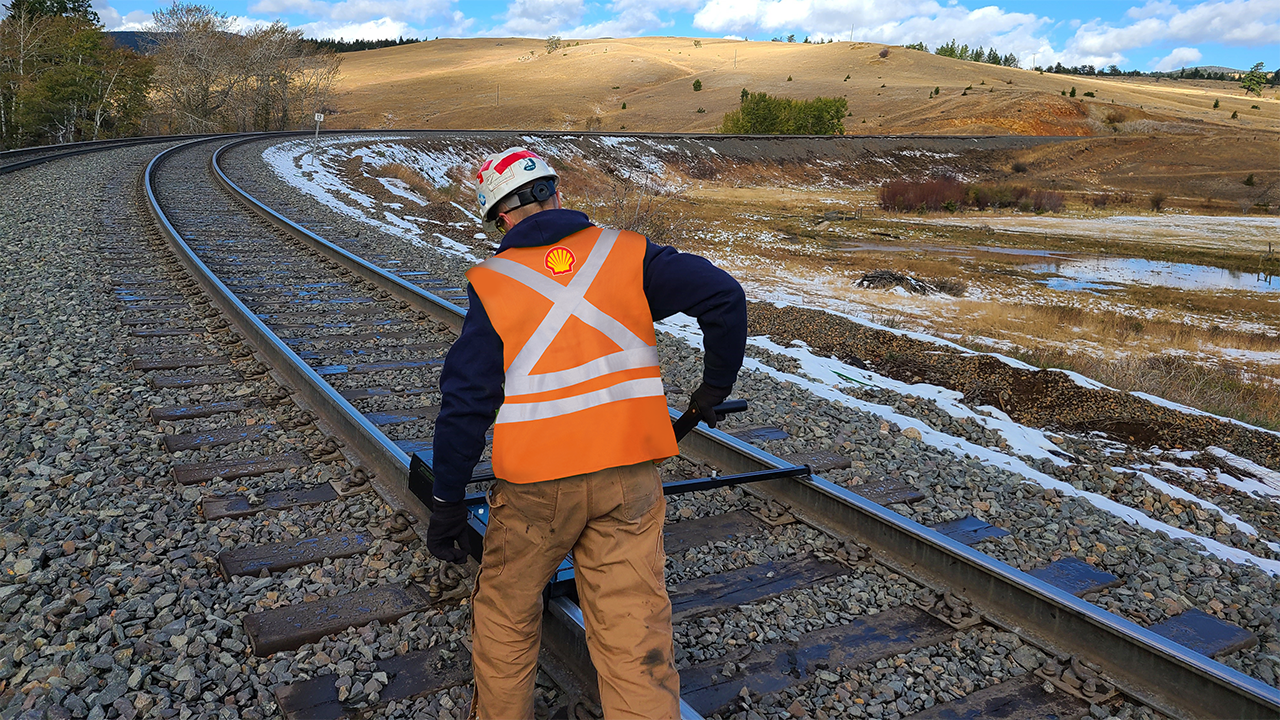
Shell & Whitmore Reliability Solutions: Coefficient of friction measurement with a hand-held tribometer can help determine the performance of friction-modifier and lubricant carry down.
RAILWAY AGE, JULY 2022 ISSUE: Reducing rail wear and mitigating noise in tight curves are among the benefits of lubrication and its high-tech equivalent, friction management.
Suppliers are helping freight railroads and transit agencies maximize safety and performance with lubrication/friction management programs—all while reducing costs. Below, they share how, plus their latest products and market outlooks.
L.B. Foster
Freight railroads today are increasingly looking to their friction management programs to maximize fuel savings, according to John Cotter, General Manager for Friction Management-Americas. “An effective program, where we’re lubricating the wheel/rail interface, can reduce train resistance, which leads to an overall reduction in fuel consumption,” he tells Railway Age. “So in today’s inflationary environment and with fuel one of the railroads’ largest expenses, they want to make sure that they’re leveraging their programs. On the transit side, I think we are seeing a slow return to normal. We’re not quite there yet in terms of traffic, which does influence what we see in terms of spending on consumables and friction management in general, but we are seeing a trend in the right direction to where we were pre-pandemic.”
Customers across the board are seeking value, improved efficiency and reduced downtime, Cotter says. That’s why interest in remote monitoring of lubrication and friction management equipment is on the rise. Some larger railroads take the raw data and analyze it themselves to determine unit performance, while others look to L.B. Foster to convert that data into something meaningful, such as program uptime.
Now in the pipeline at L.B. Foster are pole-mounted units for transit applications. “We have a design that’s been successful in the European market that we are looking to bring to North America for applications where there are space constraints—like subway tunnels,” Cotter says. “We’re also making improvements to our MC-4 applicator bar design to reduce clogging. On the freight side, we’re developing an automated switch plate lubrication unit for use on the main line with possible rollout next year.”
Railroads of all sizes continue to see the benefits of friction management, Director of Product Management Bruce Wise reports. “Class I’s tend to install their systems ‘out of face,’ where short line and regional railroads tend to focus on specific curves or challenging areas where rail damage or track integrity is especially important.”
To ensure system uptime, remote monitoring use is growing, he says. “Our latest generations are highly reliable and require very little power. Traditionally, many of the remote monitoring systems available were less reliable than the equipment they were monitoring—that is changing.”
New at Loram is an updated 25-gallon/200-pound wayside tank and a modular version accommodating up to 200 gallons/1,600 pounds. “Our R&D focus has always been to continue to optimize our existing product lines and design them to be more robust, reliable, and easier to install and maintain,” Wise says.
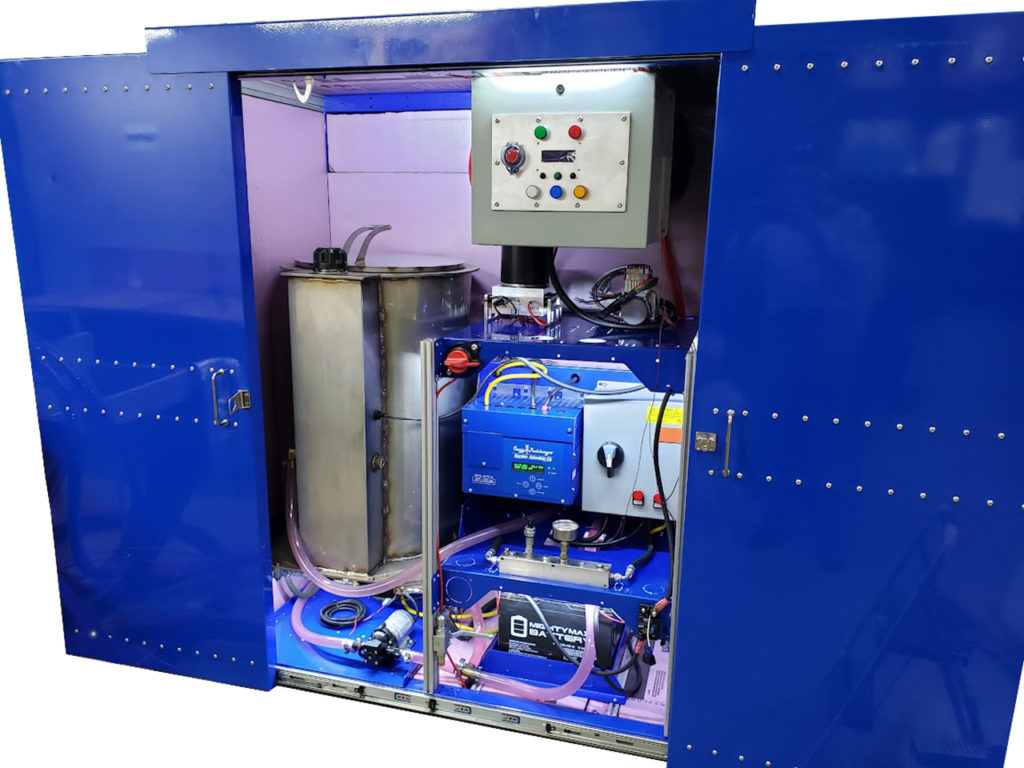
Current market conditions are strong, “as it appears that more emphasis is being applied to friction management for minimizing rail wear and all related issues,” Manager of Railroad Sales Christian Pieper tells Railway Age. And with “limited manpower for ‘boots on the ground,’ remote monitoring capabilities are more desired,” he notes.
RBL Inc./Robolube is currently working on a tow-behind lubricator that allows transit agencies and streetcar systems to grease the rail without hi-rail vehicle use. Additionally, “with our new wireless remote for our Hyrail lubricators, we are looking at putting in the palm of your hand all current functions as well as fault and data controls with a small LCD handheld device,” Pieper reports. “This will eliminate our control panel in the cab.”
Shell & Whitmore Reliability Solutions, LLC (SWRS)
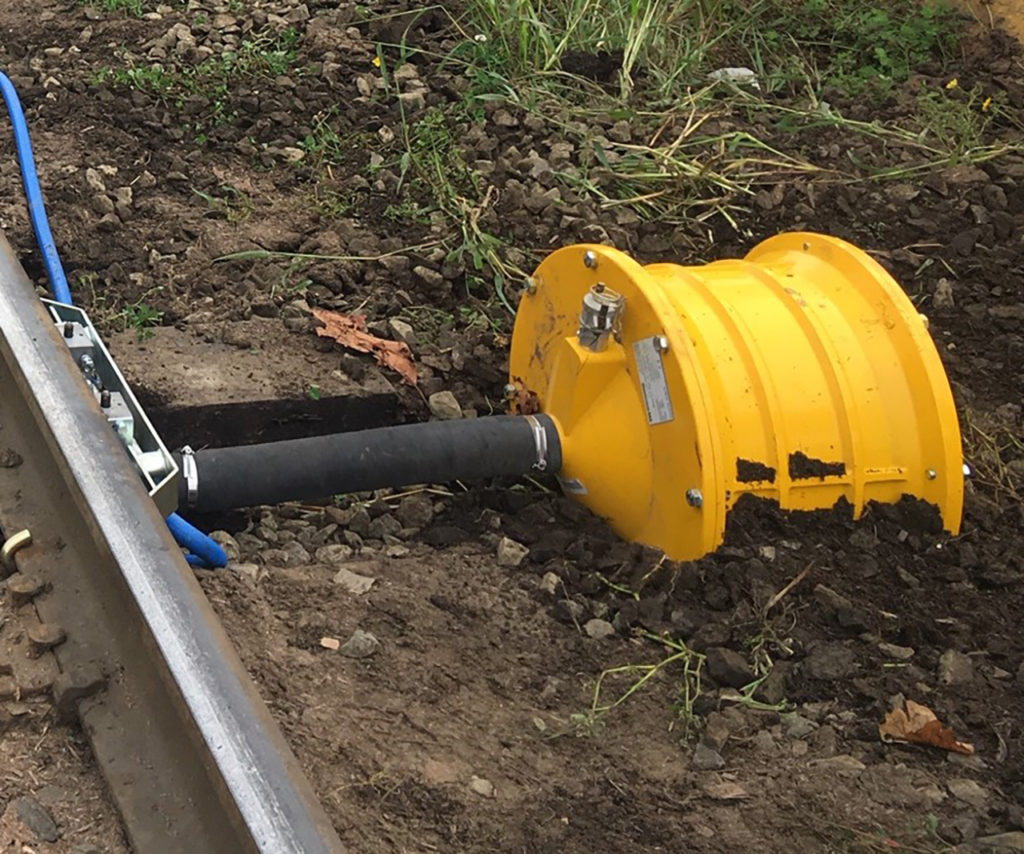
In April 2021, Shell and Whitmore formed a 50:50 joint venture, Shell & Whitmore Reliability Solutions, LLC, to provide an integrated portfolio of proprietary products for North American Class I, II and III railroads and U.S. mining companies (excluding quarries). Among them: rail curve greases, top-of-rail friction modifiers and switch lubricants as well as mining lubricants, plus locomotive engine oil, traction motor bearing grease, and journal bearing oil, according to Technical Sales Manager Rail Kevin Adkins.
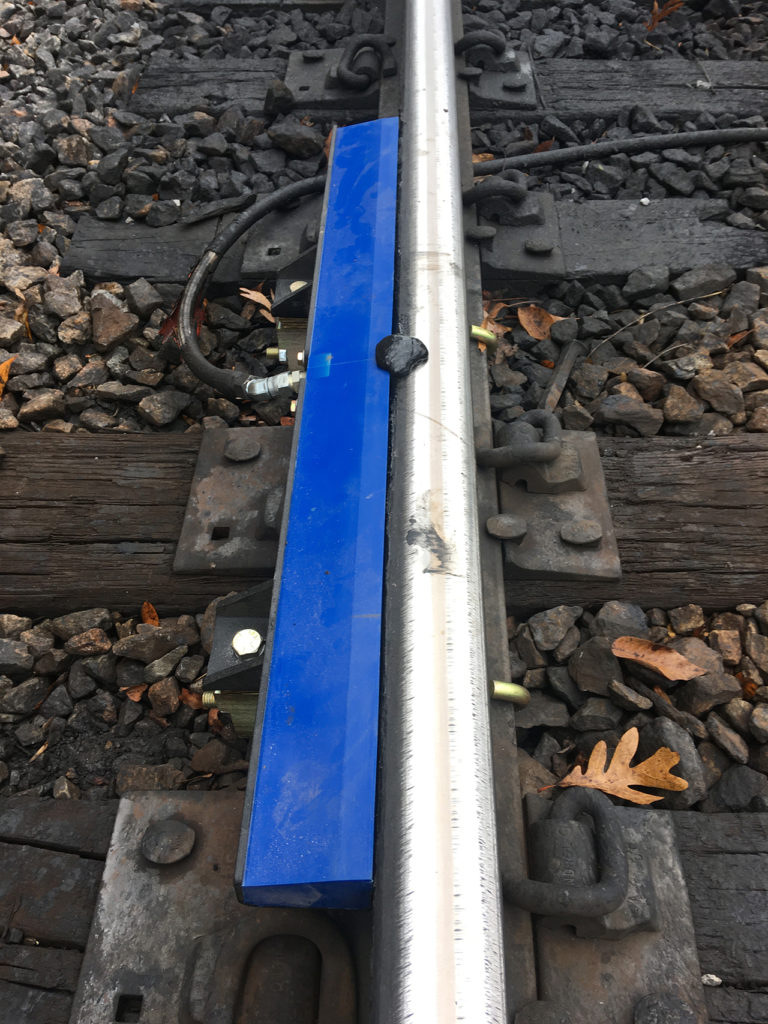
“This past year has certainly been a challenge for both the railroads and suppliers alike,” Adkins says. “The increase in cost of base oil and additives has forced suppliers to pass these increases on to the railroads for friction management products. Supply chain issues have created long lead times for some products. Railroads have had to scramble to keep their friction management programs going. As far as services, it appears more railroads are interested in contracting out the filling services of wayside lubricators and in some cases the maintenance of those units.”
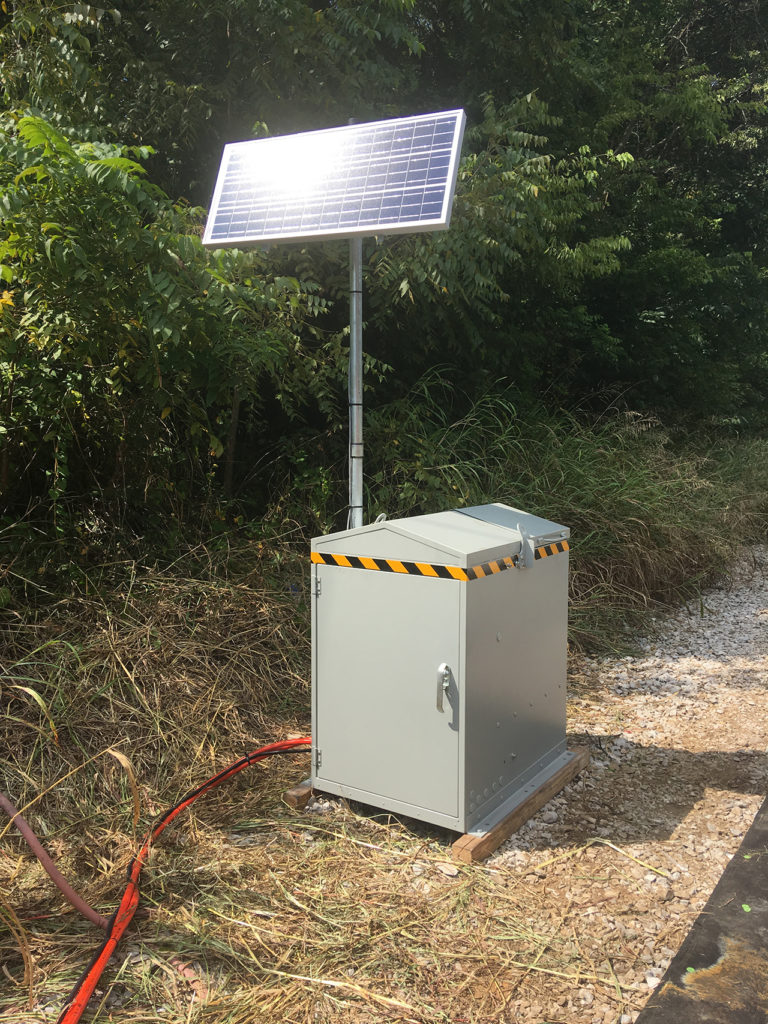
As supply chain issues slowly improve, Adkins tells Railway Age he is optimistic about market outlook, long term. “With the major increase in the cost of steel, it is now more important to prolong the life of assets like rail and train wheels,” he says.
Like L.B. Foster, SWRS is seeing Class I’s look to their friction management programs to save on fuel. Programs using top-of-rail friction management, such as Shell Gadus TOR Amor, can help reduce fuel use, according to Adkins. Another area of interest: all-season rail curve grease. Use of Shell Gadus Rail Armor M and Shell Rail Gadus S3 eliminates the need for a seasonal change-out, and there is no need to adjust output for temperature swings, Adkins says.
SWRS is now looking at improved rail curve grease thickeners, which will boost “pumpability.” It is also reformulating locomotive engine oils and gear oils to meet AAR specifications and continuing testing on a low-temperature top-of-rail friction modifier.
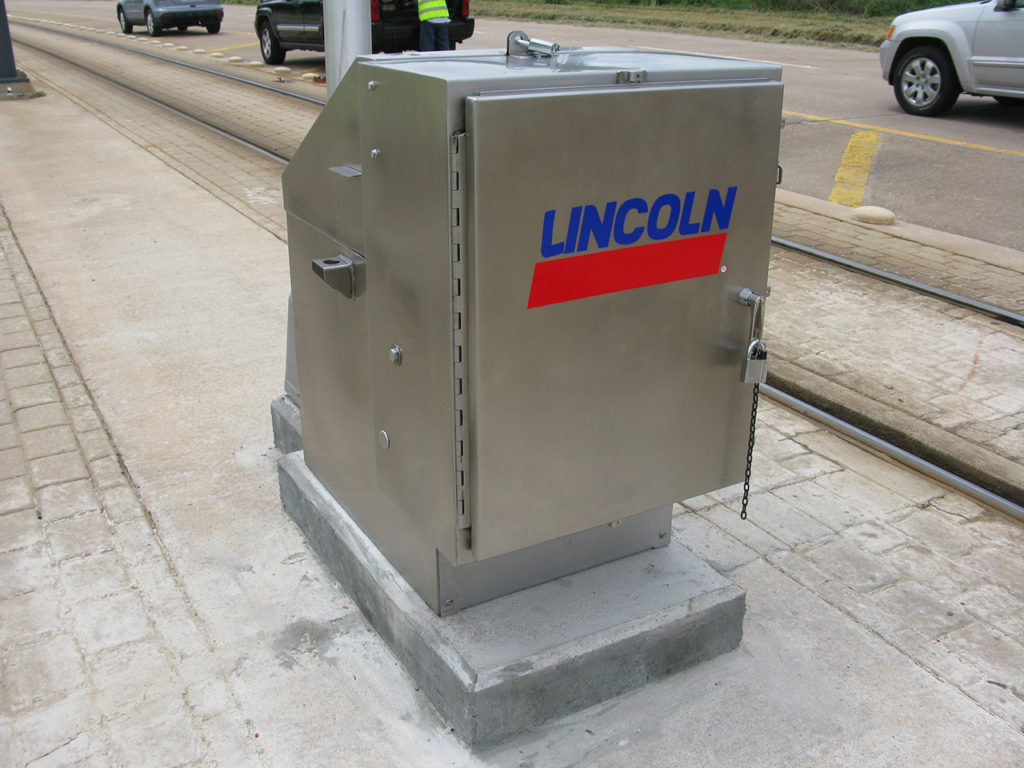
“SKF’s Lincoln wayside system utilizes precision metering devices, non-contact wheel sensors and a high-pressure pump capable of 5,000 psi,” reports Doug Conger, Director of Lubrication Engineering for North America. “These elements work together to ensure that the exact amount of lubricant is applied to the gauge face in predetermined intervals.”
The system is also capable of lubricating multiple tracks in rail yards, for instance. “A loop may have three or more concentric tracks where normally multiple reservoir units would be required,” Conger points out. “With a Lincoln wayside system, the three tracks can be controlled separately with a single reservoir, pump and controller. This consolidation reduces the overall footprint of reservoirs required for the application.”
Remote monitoring has been a feature of SKF’s Lincoln systems for years, providing instant updates on the health of the lubricator. “Receiving feedback on grease level, solar power and axle count is extremely valuable data that is used for effective maintenance planning,” Conger says.
Customers are more often requesting biodegradable lubricants to support environmental efforts, he adds. “The Lincoln wayside lubrication system can pump an NLGI #2 bio grease and can also accommodate many types of curve greases that are used in the rail industry,” he says. “The precise application of these greases greatly reduces spillage by enabling the wheels to pick up and transfer the grease down the rail.”
TRAC Lubricants & Coatings LLC
Yeadon, Pa.-based TRAC has been helping to solve lubrication and corrosion problems for the freight rail and transit industry since 1992, Vice President and General Manager Rudy Rorer tells Railway Age. The company offers five switch plate lubricants, including two that are biodegradable (Ultra Green and Ultra Glide), and a variety of rail/flange lubricants. Winterized versions—for applications in temperatures down to –30 to –40 degrees F—are also available. “We continue to develop new formulas that are environmentally friendly while utilizing materials that will require less frequent application, reducing manpower requirements,” Rorer reports.
TRAC is now refining a dry film lubricant (molybdenum disulfide) for switch plates and rail flanges to replace grease or other liquid lubricants. “Moly-disulfide is an inert material, so it’s environmentally friendly, and once it goes on, it breaks down and burnishes itself into the metal, so you will get a longer wear—something like 30%—and see less wear and tear on your switches,” he explains. It is expected to be commercially available within the next 12-18 months. The company is also looking into another film application—not only for switch plates but also for rail curves—that would mix moly-disulfide and water.
